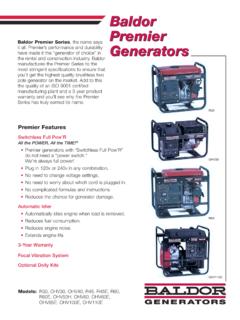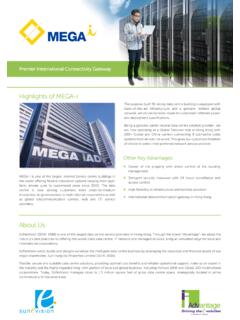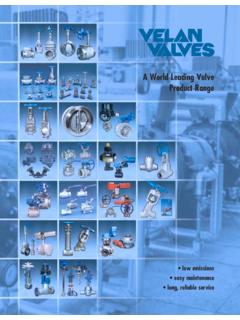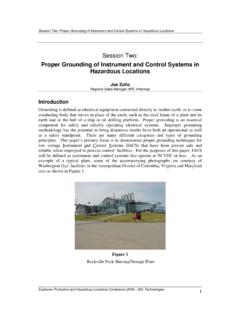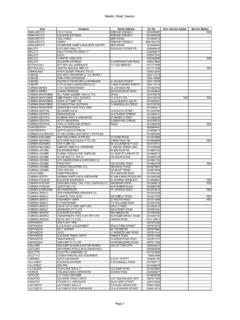Transcription of Recovery of CO2 from Flue Gases: Commercial Trends
1 Recovery of co2 from flue gases : Commercial TrendsOriginally presented at the Canadian Society of Chemical Engineers annual meetingOctober 4-6, 1999, Saskatoon, Saskatchewan, CanadaAuthors:Dan G. Chapel 949-349-7530)Carl L. Mariz 949-349-7530)FluorDanielOne Fluor DriveAliso Viejo CA, 92698 John Ernest 818-576-4293)Advanced Quality Services Inc11024 Balboa Blvd. PMB154,Granada Hills, CA 91344-50071 Recovery of co2 from flue gases : Commercial TrendsOriginally presented at the Canadian Society of Chemical Engineers annual meetingOctober 4-6, 1999, Saskatoon, Saskatchewan, CanadaAuthors:Dan Chapel - Fluor Daniel Inc., Senior Vice President Technology; Oil, Gas & PowerJohn Ernest - Advanced Quality Services Inc., Validation EngineerCarl Mariz - Fluor Daniel Inc.
2 , Director, Process Engineering; Oil, Gas & ABSTRACTI nterest in Recovery of carbon dioxide (CO2) from flue gases is being propelled by multiple factors: themerchant CO2 market, renewed interest in enhanced oil Recovery (EOR), and the desire to reducegreenhouse gas emissions. This paper reviews the latest operating and capital cost data for the FluorDaniel Econamine FGSM process. It also recaps the key process design and operating issues for aminechemical solvent CO2 Recovery processes and summarizes the competitive processes for CO2 recoveryfrom flue Econamine FG process has proven, reliable operations with both natural-gas and fuel oil-derived fluegases in plants ranging in size from 6 to 1000 tonne/day (te/d) CO2 and in pilot plant operation with coal-derived flue gases.
3 No flue gas CO2 Recovery process can compete in the merchant CO2 market in areaswhere CO2 is available in sufficient quantity from by-product sources such as fermentation, natural gassweetening and ammonia and hydrogen manufacture, or from CO2 wells. However, where by-productCO2 is not available, the Econamine FG process has favorable costs for plants of 6 te/d and larger. Theprecise cost of a given plant will vary due to the plant size, the market price of CO2, the flue gas source,and government regulations, Single-train plants of more than 4000 te/d are now possible, and economy ofscale, together with the ongoing development of the Econamine FG process, have the potential ofdelivering CO2 at a price approximately half that of a 1000 te/d INTRODUCTIONC arbon dioxide is used in the food industry in carbonated beverages, brewing, and flash drying.
4 Itsindustrial uses include enhanced oil Recovery (EOR), welding, chemical feedstock, inert gas, firefighting,and solvent extraction as a supercritical fluid. It is an essential ingredient in medical oxygen, where inlow concentrations it acts as a breathing largest potential market for CO2 is in EOR. The major CO2 sources that can be considered for theEOR market are:Natural sourcesCO2 wellsIndustrial byproductsnatural gas sweeteningsynthesis gas production2 Flue gasesFossil fuel -fired power plantsIndustrial furnacesCement plantsEngine exhaustsLime kiln exhaustsThe most economical sources of CO2 are CO2 wells and natural gas sweetening or synthesis gaspurification byproducts. The price of crude oil in 1999 ($12 to $16 per barrel) did not justify the recoveryof CO2 from flue gas sources for EOR purposes, however the recent crude price rise to $25 to $35 perbarrel can justify flue gas derived CO2 for gases have long been an important source of CO2 for the merchant CO2 market, especially in remotelocations where by-product CO2 sources are unavailable.
5 In the simplest case, fuel is combusted toproduce flue gas. CO2 is then extracted from the flue gas using a dilute MEA solution, as sufficient heatis available from the combustion process to support the heat required for the CO2 capture. This process iswidely used but is wasteful of energy. Where a source of flue gas is available and lower energyconsumption is desired, skid-mounted units employing the Econamine FG technology can be utilized. Atpresent eleven such units are in operation to recover CO2 for the food and beverage oil Recovery by CO2 flooding has been described by Taber and others (1, 2). In many casesCO2 flooding is the most cost-effective method for extracting the final amounts of recoverable oil fromdepleted fields. The Econamine FG process (known as the GAS/SPEC FT-1TM process prior to 1989when Fluor Daniel purchased the technology from Dow Chemical) and related processes were used inseveral plants in West Texas to recover CO2 from boiler flue gas for EOR purposes between 1982 and1986.
6 The plants were technical and Commercial successes, and were shut down only because of thecrude oil price collapse in by CO2 flooding requires large quantities of CO2 at low prices. The acceptable price of CO2depends critically on both the price of crude oil and the amount of CO2 required to produce a barrel (Bbl)of oil. The market price of CO2 varies widely, for instance $13/tonne delivered at pressure in Canada in1997 and $55/tonne in the in 1986. In 1985, the North American EOR market was commerciallysuccessful with a US $30/Bbl oil price and a CO2 price of approximately $1 to $2/103scf, which isequivalent to $19 to $38/tonne CO2. The amount of CO2 required for EOR is between 5 and15x103scf/bbl oil recovered (3). At a makeup CO2 rate of 6x103scf/bbl, suggested by Tontiwachwuthikul(4), and a CO2 price of $19/tonne, CO2 Recovery from flue gas adds $6/bbl to the oil production flue gas CO2 Recovery process can presently compete with by-product CO2 where it is available insufficient quantity.
7 However, where by-product CO2 is not available, or if the merchant price of crude oilremains at its present levels, the Econamine FG process and other similar competing processes will againbecome economically paper provides the basic technical and economic guidelines for evaluating various flue gases as CO2sources and indicates the issues involved in an economic analysis. It also reviews important design andcost issues for flue gas Recovery and the applicable ECONAMINE FG PROCESSThe Econamine FG process is today's premier commercially proven process for the Recovery of CO2 fromflue gases, using an inhibited 30 MEA solution. These features allow the widespread use of carbonsteel and give the process the lowest stripper reboiler steam demand of all of the well-establishedcommercial processes.
8 It can recover 85-95% of the CO2 in the flue gas and produces a +% pureCO2 product (dry basis). The inhibitor not only tolerates oxygen and NOX-containing flue gas, but alsorequires oxygen to maintain its activity. The process can be used with SOX-containing flue gas after SO2scrubbing. The additional SO2 scrubbing returns an environmental benefit. Coal-derived flue gasesusually have better economics as the process is more efficient with the higher CO2 Econamine FG process is a typical, regenerable alkanolamine process. The standard process flowdiagram is presented as Figure 1. The process is described by Mariz (3).The Econamine FG process is not applicable to reducing gas streams, for instance streams containinglarge amounts of carbon monoxide and hydrogen, on streams that contain more than 1 ppm hydrogensulfide, or on streams that have less than 1 vol% oxygen.
9 The process is applicable to pressurized gasstreams, but the full Commercial advantage of this process lies in atmospheric pressure Commercial HISTORY OF THE ECONAMINE FG PROCESSDow Chemical and Union Carbide developed inhibited 30 MEA processes for Recovery of CO2 fromflue gases in the 1970's and 1980's primarily for the EOR market. When the price of crude oil droppeddramatically in 1986, the EOR market disappeared and these licensors became less active. DowChemical sold its GAS/SPEC FT-1TM process to Fluor Daniel, Inc. in 1989. Fluor Daniel renamed thetechnology Econamine FGSM. The licensing history of the Econamine FG and predecessor FT-1 processesis shown in Table 1. Twenty-one Commercial plants have been built, including ten large plants (60 te/dand larger) and eleven skid-mounted plants.
10 Eight of the large plants are still operating. Fluor Daniellicensed three of these Commercial plants, a 320 te/d CO2 plant in Bellingham, Massachusetts forNortheast Energy Associates; a 150 te/d plant for Sumitomo Chemical in Chiba, Japan; and a 90 te/dplant for Prosint Produtos Sint ticos in Rio de Janeiro, Brazil. Fluor Daniel also constructed theBellingham plant. Prior to this, Dow had licensed six Commercial plants ranging from 6 to 1000 eleven facilities employing skid-mounted Econamine FG process units have capacities ranging from6 to 50 te/d and are manufactured by the Wittemann Company of Palm Coast, Florida and UnionEngineering of Fredericia, of the large Commercial plants use flue gas resulting from the combustion of natural gas, except theSumitomo plant which fires a variety of fuels including heavy fuel oil.



